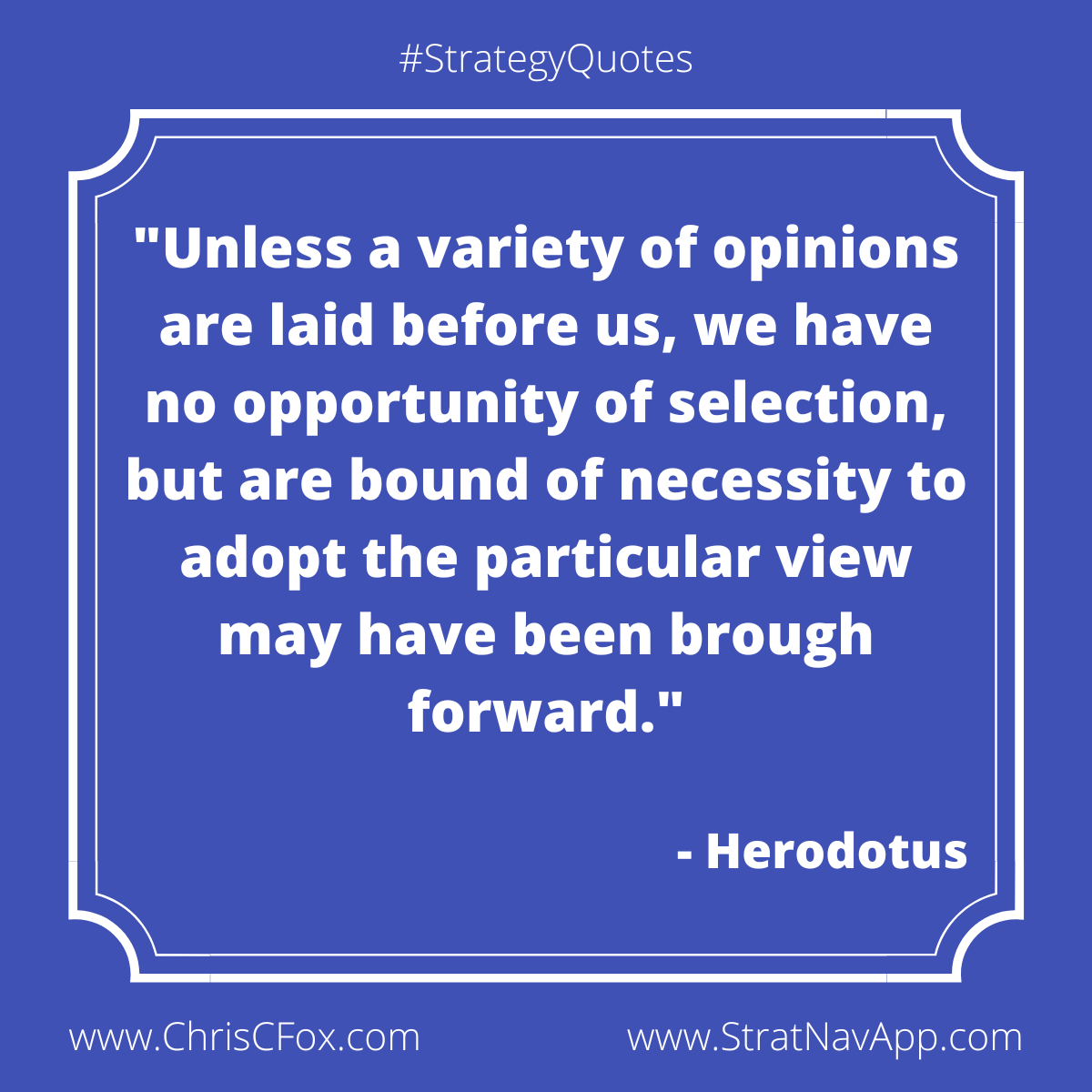 What is Hobson's Choice in Business Strategy?
What is Hobson's Choice in Business Strategy?
Strategy is about choice.
Especially about choosing to be different and to do different things.
But it has to be a *real* choice.
And a real choice requires real options.
A choice without real options is known as a Hobson's Choice
If a choice is presented as: we can invest in strategy A or we will go bankrupt, it is not a real choice.
It's not exactly business strategy either.
It's just the only thing you can do.
So when doing strategy, always challenge yourself to come up with at least two viable options.
If you don't have at least two viable options, keep looking. Seek out the minority voices and heretics. Don't settle.
Then, when you choose one over the other, you're much more likely to be committed to it and follow it through.
7 techniques for generating strategy options
There are a number of ways to generate options, for example:
- Use Ansoff’s matrix to consider all the possibilities of selling:
- existing products to new customers (new geographies, customer segments, etc),
- new products to existing customers, or even
- new products to new customers.
- Use the innovation templates for a systematic approach to developing new products and services.
- Use Porter’s generic strategies as a framework for choosing between and developing options based on either:
- Cost Leadership,
- Differentiation or
- Focus.
- Add, change or remove a competitive factor on your Strategy Canvas. This is best done using the Voice of the Customer (VOC) off the back of customer research.
- Develop options which flow directly from the insights in your SWOT analysis (see below).
- For a portfolio of businesses or products, use a BCG Analysis or a Pareto Analysis to understand and develop your options for shaping the portfolio.
- Ask people for ideas (see below).
Developing options from the insights in your SWOT analysis
Weaknesses:
- Strengthen your capability or acquire the resources
- Partner with someone who is strong at it
- Avoid it by focusing on customer segments who value it less highly
- Discount opportunities which rely on it
Strengths:
- Find other products, services or customer segments which rely on it
- Promote it to your customers
- Target customers who prize it most highly
Opportunities:
- Invest in building and using related strengths
- Position and promote yourself as a leader in the field
- Conceal your intentions so that competitors are less aware of the opportunities
Threats:
-
Exit or de-emphasis directly affected markets
-
Capitalise on a competitor's weaknesses in this area
-
Seek to neutralise it
Look especially for examples where your strengths play into opportunities. And take evasive action where your weaknesses most expose you to threats.
See also: How to do SWOT analysis? (With example and template)
Don't forget to just ask people
In addition to using the other techniques, don't forget the simplest one of all: just ask people what they think you could or should do. You could ask colleagues, customers, distributors, suppliers, and, of course, professional consultants. When doing so, it is best to follow the brainstorming guidelines of suspending judgment of those ideas until later.
5 tips for generating strategic options
The purpose of developing options is to allow for choice. As Porter said:
"Strategy is about making choices, trade-offs; it's about deliberately choosing to be different."
Here are some tips to ensure your options allow for real choice.
- Don't just stop once you've found an option you like.
If you do, you'll never know if the next option would not have been even better. Work through the full range of options. - Look for options which are mutually exclusive and/or involve tradeoffs.
This will help to ensure you're making the really tough calls to differentiate yourself in the market, and not simply executing as many of the ideas as you can.
For example: Airline brands must typically choose to position themselves as either 'discount' or 'premium'. By eliminating meal options, discount airlines can reduce flight turnaround times and costs (well beyond the cost of the meals themselves). However, this would deter premium customers.
Far from being a limitation, such mutually exclusive options are strategically valuable. They allow different competitors to take up different positions without competing head-on. - Beware Hobson's choice.
Hobson's choice creates the illusion of choice by positioning one option as the only alternative to either doing nothing or failing. I've seen people do this when they only really have one option (see tip 1).
For example: We must replicate a competitor's last move or lose market share. Instead, ask: What else could you do to retain and even grow market share? - When faced with a large number of options, group mutually reinforcing options into themes.
Strategy is a pattern of decision making, rather than a number of decisions made independently of each other. Grouping options into themes can help to highlight those patterns. Some options can be included in more than one theme.
In extreme cases, themes can have their own vision and mission statements. Values, however, should remain consistent across all the options and themes.
Theming options presents you with two levels of choice: - which themes to pursue / not pursue, and
- which options to pursue / not pursue within them.
- Suspend judgement until the end
Resisting the temptation to judge options as either good or bad too early in the process. This will cloud your judgement. An option which does not appear very good in isolation might be a vital component of a very powerful theme.
